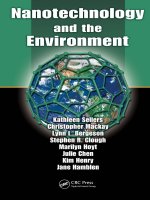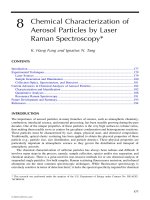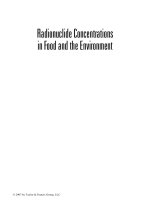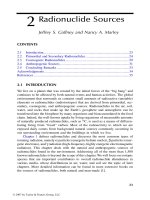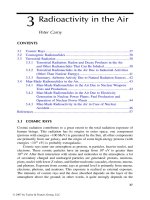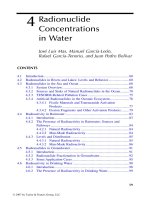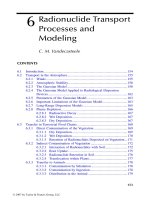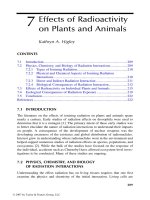Nanotechnology and the Environment - Chapter 8 potx
Bạn đang xem bản rút gọn của tài liệu. Xem và tải ngay bản đầy đủ của tài liệu tại đây (500.04 KB, 24 trang )
© 2009 by Taylor & Francis Group, LLC
169
8
The Potential Ecological
Hazard of Nanomaterials
Stephen R. Clough
Haley&Aldrich
Puzzles eventually have answers; mysteries, however, cannot. Unknowns or uncer-
ta
intiesprecludeadenitiveanswertoamystery[1].Amystery“canonlybeframed,
by identifying the critical factors and applying some sense of how they have inter-
acted in the past and might interact in the future. A mystery is an attempt to dene
ambiguities”[1].Initsinfancy,nanotechnologycanseemmysterioustoboththe
layperson and the scientist. Science now enables us to construct nanomaterials but,
paradoxically,somegenerallyacceptedscienticprinciplesdonotappeartoapply
to their inherent biological activity. For example, a substance like gold that is physi-
ologically inert at the microscale has been shown to have biological activity at the
nanoscale [2]. This change, in effect, can result from the fact that a particle that is
lessthan100nanometers(nm)insizecanbehavemoreaccordingtothelawsof
CONTENTS
8.1 Underlying Pri nciples of Ecological Exposure, Effect s, and “R isk” 170
8.1.1 Terrestr ial vs. Aquatic Ecosystems 170
8.1.2 Risk and Hazard 171
8.1.3 Toxicity 171
8.1.4 Exposure 173
8.2 Factors That Can Affect the Toxicology of Nanomaterials 174
8.2.1 Toxicity of Nanomateria ls 174
8.2.2 Exposure to Na nomateria ls 177
8.2.2.1 Sources and Routes of Exposure 177
8.2.2 .2 Exposure and Dose 178
8.2.3 Sum ma ry 179
8.3 Anticipated Hazards To Terrestrial Ecosystems 179
8.4 Anticipated Hazards to Aquatic Ecosystems 180
8.4.1 Methodologies for Evaluating Hazards and their Limitations 188
8.4.2 Discussion of Results 189
8.5 RecommendationsforManagingtheRisksofFutureNanomaterials
and their Product ion 190
References 190
© 2009 by Taylor & Francis Group, LLC
170 Nanotechnology and the Environment
quantum physics than Newtonian physics. As the science emerges, the mysteries of
nanomaterialswillbecomepuzzlesthatwillbesolved.Thescienticparadigmsfor
nanotechnologymaytakemuchlongertodecipherbecauseconventionalscientic
methodologies,instrumentation,orprinciplesmaynotapplyinsomeoftheupcom
-
in
gstudies.Manyfearthatregulationsputintoplacetoprotectboththeworkplace
andtheenvironmentwillbetoolittle,toolate.
This chapter discusses one of the mysteries surrounding nanotechnology and pres
-
en
ts data that scientists will ultimately use to solve the puzzle. It faces the question:
“Ifananomaterialweretobereleasedintothegeneralenvironment,woulditposea
signicant risk to ecological organisms such as sh or wildlife?”
Theanswerbeginswithsomebackgroundinformationonhowtoxicologistsassess
impacts to sh and wildlife, referred to in ecological assessments as “ecological
receptors.”
8.1 UNDERLYING PRINCIPLES OF ECOLOGICAL
EXPOSURE, EFFECTS, AND “RISK”
This section provides a brief primer on ecological risk assessment, to provide the
readerwiththecontextfordiscussingthepotentialhazardsofnanomaterials.
8.1.1 TERRESTRIAL VS. AQUATIC ECOSYSTEMS
Because of obvious differences in habitat, ecotoxicology comprises two main cat-
egories of environmental assessment: (1) terrestrial and (2) aquatic. The former
category addresses the impacts of chemicals released into the environment on ter
-
restrial species. Examples include invertebrates such as earthworms, bees, beetles,
andgrubs;birds,includingdoves,quail,robins,andhawks;reptiles,suchaslizards
and snakes; and mammals, such as shrews, mice, foxes, or bears. The latter category
includes aquatic species, such as phytoplankton (e.g., single or multicellular algae),
zooplankton (e.g., rotifers, cladocercans, paramecia), benthic invertebrates and
insect larvae (e.g., mayies, caddisies, stoneies) and sh (e.g., embryos, fry, juve
-
ni
les,oradults).Ofcourse,someanimals—forexample,amphibianssuchasfrogs,
toads,andsalamanders—mayspendportionsoftheirlifecycleinboththeaquatic
and terrestrial environment. Organisms in a third category, semiaquatic receptors,
strongly depend on waterbodies for food or sustenance. These semiaquatic recep
-
to
rs include sh-eating birds (e.g., kingsher, heron, osprey, and eagle) or mammals
whose habitat is primarily aquatic (e.g., beaver, muskrat, and otter).
With the possible exception of some deserts, these different types of habitat are
notmutuallyexclusive.Theforcesofthewatercyclewillstronglyaffectboththefate
andthetransportofcontaminantswithinaterrestrialecosystem.Inaddition,animal
activitycanaffectmarkedlythelandscapeofaterrestrialecosystem.Theleg-trap
-
pi
ngofbeavers,forexample,wasonceanacceptedmethodintheUnitedStatesto
obtaintheirthickpelts.Manystates,however,nowviewthesetrapsasinhumaneand
have banned their use. Consequently, their populations are back on the rise and, as a
© 2009 by Taylor & Francis Group, LLC
The Potential Ecological Hazard of Nanomaterials 171
result, their natural impoundments are transforming once-dry forest land into large,
productive wetlands.
Because of the limited data available regarding the effects of nanomaterials on
ecological receptors in the wild, this chapter rst examines the underlying principles
thatmustbeinplacefortheretobeavalidsuppositionthatnanomaterialsmayeven
-
tu
ally pose a risk to any terrestrial, aquatic, or semiaquatic organisms/receptors.
8.1.2 RISK AND HAZARD
Riskisgenerallydenedastheprobabilitythatahazardwilloccurinagiventime
and space. It is virtually impossible to determine the probability that a chemical may
posearisktoanorganism,population,orcommunityinthewild.Thus,theterm
“ecologicalrisk”issomethingofamisnomer.Theterm“hazard,”whichisthelikeli
-
ho
odthatanadverseeventcantakeplace,betterexpressesthedegreeofharmtoan
ecological receptor. However, these terms often are used interchangeably.
Risk(orhazard)isafunctionoftoxicityandexposure.Unlessanecological
receptorisexposedtoachemicalornanomaterial,therecanbenoriskorhazard.If
exposure is great enough, substances that have a low inherent toxicity can still result
inatoxicresponse.Paracelsus,knownastheFatherofModernToxicology,stated
that“[a]llsubstancesarepoisons;thereisnonewhichisnotapoison.Therightdose
differentiatesapoisonandaremedy.”Thus,ifenoughofasubstanceofknown(but
low) toxicity is ingested, a hazard may exist. Although table sugar is classied as
virtuallynon-toxic,eatingtoomuchcakeorcandywillresultinnauseaand/orvom
-
it
ing,atoxicresponseelicitedbytheover-consumptionofsugar.
The potential for harm also depends on the duration of exposure. Short-,
medium-,andlong-termcontactwiththematerialinquestionarereferredto,respec
-
ti
vely,asacute(singledose),subchronic(multipleexposuresover2to3months),and
chronic (greater than 3 months to a lifetime) exposures. Over time, some animals
can become tolerant to some materials, or cross-tolerant to similar materials. A good
exampleisthehighlytoxicmetalcadmium.Anacuteexposureofanorganismtothe
metal will impart tolerance or resistance to subsequent exposures due to the induc
-
ti
on of metal binding proteins by various tissues.
8.1.3 TOXICITY
Ecologicalhazardassessmentscanfocusonindividualsorpopulations.Individual
organismscanbeexposedtonanomaterialsviainhalation,dermalcontact,and
ingestion.Exposurepathwayshistoricallyhavebeenframedinthecontextoffood
webs that embody many different types of autotrophic and heterotrophic interac
-
ti
ons. Persistent, bioaccumulative, and/or toxic substances (PBTs) will bioconcen-
tr
ate, bioaccumulate, and/or biomagnify in a food web.
Scientists generally divide the evidence of ecological harm into two classes of
effects criteria: (1) Assessment Endpoints and (2) Measurement Endpoints. They
generallyascribeAssessmentEndpointstoaless-tangible(ormoresubjective)value,
suchas“WillChemicalX,ifreleasedintotheenvironmentatConcentrationY,have
an adverse effect on the population of predatory sh?” A Measurement Endpoint is
a more specic, objective measurement at the individual or community level that
© 2009 by Taylor & Francis Group, LLC
172 Nanotechnology and the Environment
supportstheevaluationoftheAssessmentEndpoint,suchas:“WhatistheConcen-
trationYofChemicalXthatwilladverselyaffect20%ofaknownpopulationof
rainbow trout in the laboratory?”
The main endpoint for measuring ecological toxicology is the LD50, or the
lethal dose required to kill 50% of the organisms under controlled laboratory testing
conditions.Foraquaticorganisms,theLC50andEC50(ortherespectivelethalcon-
centrationandeffectconcentrationrequiredtokilloraffect50%oftheorganisms)
arethemoreappropriatetermsusedforatoxicityendpoint.Whendoseisplotted
versus response, the slope of the curve is a general indication of the potency of the
toxicant: the steeper the slope, the more potent the toxicant relative to chemicals of
asimilarclass.
Onecangeneralizeabouthowthesecriteriawillreecttherelativetoxicityof
a substance based on its structure and the principle that like dissolves like. Because
cell membranes primarily comprise a lipid bilayer, lipophilic or fat-loving substances
are, as a general rule of thumb, more toxic than hydrophilic or water-loving (soluble)
substances. Lipophilic substances are more easily absorbed by inhalation, ingestion,
ordermalexposure,andtendtohavealongerhalf-life(i.e.,thetimerequiredto
reducethebodyburdenofatoxicantbyone-half,eitherbymetabolismorexcre-
ti
on), while water-soluble substances are more easily metabolized by the liver and/or
excretedbythekidneyandthustendtohaveashorterresidencetimeinthebody.
Intheeldofinhalationtoxicology,foreignmatterisgenerallycategorizedas
gas, vapor, or particulate (or brous) matter. The latter can affect physically the elas-
ti
city of the lung. Examples include silicosis in concrete and quarry workers, asbes-
tosis in shipyard workers, and pneumoconiosis in coal miners. Nanoparticles would
be classied as particulate matter, but because these particulates are so extraordi-
narilysmall,theyfallinatoxicologicalgrayarea.Somecomprisepotentiallytoxic
elements that, if dissociated or dissolved, may cause adverse effects inside a cell.
Therefore, they may cause adverse extracellular physical effects similar to those
caused by larger bers such as asbestos or berglass insulation, or may be actively
or passively internalized by cells and cause toxic effects by interfering with cellular
processes. Data from a battery of both in vitro and i
n vivo bioassays may be needed
to reveal to the investigator the inherent toxicity of the various elements and com-
pounds that comprise nanomaterials (for some of which there are little to no toxico-
logical data). The difculty will lie in separating whether an adverse effect reects
aphysicaleffectinducedbythenanomaterialoradirecttoxiceffectresultingfrom
the composition of the material itself.
For example, carbon black, a common nanomaterial in commercial use for
decades,isconsideredbiologicallyinert.Althoughitmayremaininthebodyin
asequesteredform,itisexpectedtohavealowinherenttoxicity[3].Incontrast,a
uniquenanomaterialconstructedfromone(ormore)elementsmaybeinherently
toxic.Considercadmium,ahighlytoxicmetalusedtomakequantumdotalloys
ofcadmiumselenideorcadmiumtelluride.Toxiceffectsonthereproductivesys-
te
morthenervoussystemareofparticularconcern.Theresponseofthesesys-
tems,ingeneral,willtakealongertimetounravelthanotherbiologicalendpoints,
becausetheendpointstakealongtimetoachieve,areexpensivetocharacterize,or
© 2009 by Taylor & Francis Group, LLC
The Potential Ecological Hazard of Nanomaterials 173
theresultsarecharacteristicallysubtle,requiringinnovativeand/orverysensitive
testing methodologies.
The natural physiological variability within a population means that individuals
mayreactdifferentlyuponexposure.Thereasonsgivenforthisvariabilityoftenare
physiological, such as internal genetic differences, or environmental. The gender
ofananimal,thespecies,oritsagecanmakeaverysignicantdifferenceinthe
responsefollowingexposuretoachemicalornanomaterial.Youngeranimalsare
generally more susceptible to toxicants than older animals, partly due to the fact that
theyweighlessandtherefore,poundforpound,willgetalargerdosethanwouldan
adultanimal.Similarly,therearesomestrainsofmicethatareveryresistanttothe
toxic effects of heavy metals, whereas other strains are overly sensitive. The results
of these variations in sensitivity can be observed in the classic dose/response curve,
whichistypicallyanS-shapedfunction.Plottedonagraph,withthedoseonthex-
axisandthepercentoforganismsaffectedonthey-axis,thecauseoftheinections
intheS-shapedcurveareduetothepresenceofsensitiveindividualsinthelowdose
ranges and tolerant individuals in the high dose ranges.
8.1.4 EXPOSURE
Acompleteexposurepathwaymustexistforananimaltobeaffectedbyachemical
ornanomaterial.Thismeansthatamechanismmustexisttotransferthecompound
or nanomaterial in question from the source in a
ir, water, soil, or sediment to the
receptor organism i
n question. Without exposure, there can be no risk. Therefore,
andthisisacriticalfactorasnanotechnologyevolves,aslongasnanomaterialsare
properlyhandledand/orcontained,riskand/orhazard(s)willbenegligible.
Scientistsusetheterm“fateandtransport”torefertoprocessesthataffectasub
-
s
t
ance as it travels from the source to a potential receptor. As described in Chapter 6,
various processes can change the nature and concentration of a nanomaterial, which,
in turn, can change its potential to induce toxicity.
Partitioningfromonephaseofmediatoanotherisanextremelyimportantphe
-
no
menonthatcanaffecttheproperties(andoftenthequantities)ofananomaterial
within an environmental medium. Partitioning typically is expressed in terms of
a ratio or partition coefcient (e.g., water-to-sediment, soil-to-water, water-to-air,
water-to-biota, etc.). For example, a bioconcentration factor (BCF) is the ratio of the
concentrationofasubstanceinshtissuetotheconcentrationinawaterbody.
Weathering, which includes the variety of chemical reactions and physical atten
-
uation processes that occur after a chemical is released into the environment, will
generallydecreaseexposure,bioavailability,and/ortoxicity.Theexceptionstothis
are compounds or materials that resist degradation, such as mercurials or arsenicals,
some types of commercial pesticides, polychlorinated dioxins and furans, and poly
-
ch
lorinated biphenyls, to name just a few examples.
Another important underlying principle in ecological toxicology is the differ-
en
cebetweenexposureanddose.Anexposure is t
hesumtotalofacompoundor
nanomaterial that reaches an ecological receptor, but the dose is a
smaller percentage
of the total material that actually enters the body. Bioaccessibility and bioavailability
© 2009 by Taylor & Francis Group, LLC
174 Nanotechnology and the Environment
also come into play. The bioaccessible fraction of a substance like a nanomaterial
wouldbetheamountofmaterialthatcanbepresentedtoatissueororganforuptake.
Forexample,ifananomaterialagglomerates,organismscannotaccesstheinnerpor
-
tionofanintactclump.Theoutside(exposed)portionoftheclumpedmaterialmay
beabletoreactwithreceptorsonacellsurfaceorpenetrateacellmembrane,and
thuswouldbebioavailable.
Althoughthedegreeofriskorhazardthatananomaterialmayposetoanani
-
malisclearlyafunctionofboththedegreeofexposureandtheinherenttoxicityof
the material, dening the latter two parameters can be quite complex. In bioassays,
some researchers will hold the exposure or dose at a steady concentration and then
evaluatetheeffectsofthematerialovertime,whileotherswillvarytheexposureor
dose and stop the experiment or study after a specied time period. The latter gener
-
a
l
ly is preferred as demonstrating dose dependence, a key principle in the science of
toxicology. Because nanomaterials can be unique compounds, many of which will
bewaterinsolubleandthereforedifculttondadosingvehiclefor,thescienceof
toxicologymayhavetoadaptnewandinnovativemethodsfortestingmanyofthese
distinctive materials as they come into the marketplace.
8.2 FACTORS THAT CAN AFFECT THE
TOXICOLOGY OF NANOMATERIALS
Willtraditionaltoxicologytestingprotocolsallowfortheproperevaluationofthe
hazard of a nanomaterial? The answer depends on toxicity and exposure. This sec-
t
i
on describes the factors that can affect the toxicology of nanomaterials. Sections
8.3and8.4presenttheresultsoflaboratorystudiestodate.
8.2.1 TOXICITY OF NANOMATERIALS
Toxicity depends, in part, on particle size, shape, and chemical composition. As
discussedpreviously,ananomaterialisdenedasasubstancethatmeasuresless
than100nanometers(nm)inanyoneofthreedimensions.Relativelyspeaking,that
is100to1000timessmallerthanmostlivingcells[4].Foranotherperspective,the
size of nanomaterials falls in between the wavelength range of ultraviolet light (450
to 10 nm) and x-rays (<10 nm). Nanomaterials, therefore, are difcult to observe or
to detect in the laboratory [5]. As particles get smaller, the surface-to-volume ratio
increases dramatically. This large amount of area presents many surfaces that can
interactwith,andpossiblyinterrupt,normalcellularphysiologicalmechanisms.For
example, titanium dioxide (TiO
2
)isarelativelyinertsubstanceatthemicroscale,
but nanoscale TiO
2
has been shown to produce reactive oxygen species (ROS) with
consequent potential for cellular damage in both prokaryotic and eukaryotic cell
cultures [6–8].
Sizeandshapealsodeterminewhereamaterialmightendupinthebody.Upon
autopsy,anormalindividual’slungwillshowapepper-likecoloration,bothatthe
surface and upon incision. This coloration results from a lifetime’s accumulation of
both natural and anthropogenic dusts and soots. The reticulo-endothelial system (or
the RES, comprising macrophages, white blood cells, and lymph nodes) sequesters
© 2009 by Taylor & Francis Group, LLC
The Potential Ecological Hazard of Nanomaterials 175
mostparticulates,makingthematerialunavailabletotherestofthebody.Toomuch
exposure,however,willoverwhelmtheRESandthelungwillbecomebrotic,
calcied, or emphysematous, losing its elasticity and eventually resulting in lung
disease. Nanomaterials may pose the greatest risk to the lung because they can be
transportedlikeagasandreachthedeepestportionofthelungs,thealveoli.The
latterstructuresarecrucialforthetransportofoxygentothearterialbloodandthe
exchange of carbon dioxide from the venous blood supply. One of the biggest chal
-
lengesinsolvingthepuzzleofthetoxicityofnanotechnologywillbetoevaluatethe
toxicity of nanomaterials to the respiratory system.
Another important factor affecting toxicity is particle shape. Nanomaterials can
be all types of shapes: amorphous, rods, wires, sheets, spheres, horns, dendrimers …
thelistcanbeaslongastheimaginationoftheinventororengineerseekinganew
productorfunction.Itisalreadyknown,formicroscaleparticlessuchasasbestos,
exhaust fumes, or smoke, that shape strongly inuences the toxicity due to particle-
surface-catalyzed reactions or the induction of stress, such as lipid oxidation, stress
proteins,orROS.
The particulate nature of nanomaterials also limits their distribution in the food
chain. Should
these m
aterials make their way into the environment in signicant
amounts, they may bioconcentrate to some degree; however, it is anticipated that
theywouldnotbioaccumulateorbiomagnifyinthefoodchainbecausetheyarestill
solidparticlesandmaynotbecomeatrulydissolvedspecies(whichisaprerequisite
forconventionaltoxicstoday,particularlyinaquaticsystemswheremacroinverte
-
bratesandshareexposedonaconstantbasisandlinkedviaafoodweb).Colloids,
humicandfulvicacids,andhydrophilicacidsareinthesamesizerange(asmaybe
some naturally occurring nanomaterials, such as volcanic dusts and silts), yet they do
notbiomagnify.Chemicalslikedioxins/furans,polychlorinatedbiphenyls(PCBs),
methyl mercury, peruorooctanoic acids (PFOAs, an ingredient of Teon
™), and
otherpersistent,bioaccumulativeandtoxiccontaminantsrequirebothalong-term
residenceinanaquaticsystemandahighorderoffugacityinordertoaccumulate
andbiomagnifyupafoodchain.Thetendencyfornanomaterialstoaggregateand
sorb onto environmental media limits their bioaccessibility. Although it is possible, it
isthereforeimprobablethatnanomaterialswouldposearisktotheenvironmentasa
result of a passive cumulative mechanism. An exception may occur if a nanomaterial
contains elements or compounds that are already known to be either extremely toxic
orbiomagnify,suchasmercury,selenium,orhighlyhalogenatedsubstances.
Thecompositionofaparticularnanomaterialalsoisveryimportantinthree
respects. First, the characteristics of a nanomaterial can differ from laboratory to
laboratory or from manufacturer to manufacturer. For example, it is already known
that single- or double-walled carbon nanotubes (SWCNTs or DWCNTs, respectively)
can differ in size, shape, and even composition, depending on the process and/or
manufacturer that produced the material [5]. It therefore can be difcult to general
-
iz
ebioassayresults.
Second,manybulknanomaterialscontainimpuritiesorbyproductsthatcan
signicantlyinuencetoxicitytoanorganisminthelaboratory[5].Similartothe
production of new materials in the early to mid-20th century, the production of new
nanoproducts differs from country to country, and byproducts may be introduced
© 2009 by Taylor & Francis Group, LLC
176 Nanotechnology and the Environment
inadvertently that vary in content and concentration between manufacturers. Work
by Plata et al. [9] illustrates this point. They evaluated the co-products of nano-
tube synthesis by testing various samples of commercially available, puried carbon
nanotubes.SamplesofSWCNTscontainediron,cobalt,andmolybdenum(usedto
catalyzenanotubesynthesis)at1.3to4.1%totalmetals.Thesamplesalsovariously
containedchromium,copper,andleadat0.02to0.3partsperthousand.Suchimpu-
rities could affect the toxicity of a sample of SWCNTs.
Third, some nanomaterials contain fundamentally toxic materials. A recent in
vitro study using human lung epithelial cells [10] showed that cobalt and manganese
enteringthecellasnanoparticlesshowedeighttimesthetoxicityoftheirrespective
water-soluble metal salts, purportedly because the latter, as ions, could not enter
thecells.Thisso-called“Trojan-horse”mechanismalsomayoperatewithquan-
tum dots produced for medical applications, which are essentially spherical heavy
metalalloyscoatedwithamaterialsuchasanimmunoreactiveproteinintendedto
haveaspecicbiologicalactivity.Ifwhitebloodcellsengulfedthesequantumdots,
thecoatingcouldbebrokendownbydegradativeenzymesandtheheavymetals
releasedintothecytoplasmofthecell.Thecentralcoreofthequantumdotthen
becomesbioavailableandthereforeabletomanifesttoxicitytovariouscomponents
within the cell.
Thedesignofexperimentsthatmeasuretoxicityalsocaninuencetheresults.
Justaswithtraditionallytoxicmaterials,theformusedfordosingananomaterialcan
throwintoquestionwhetheranexperimentisreallyscienticallyvalid.Ifananoma-
terial is practically insoluble in water, then many of the doses used in experiments
maynotbeapplicabletoreal-worldsituations.Infact,onecanndstudiesreported
in the literature that use doses or concentrations that may not be realistic should a
nanomaterialenterawastestream.Forexample,C60fullerenesareveryinsoluble
inwater.Totestthetoxicityoffullerenes,researchershaveusedasuccessiveseries
ofwater-insolublesolventsorotherarticialmeans(asdiscussedinSection8.4.1)to
get them into aqueous suspension. Consequently, many researchers question, as they
have for decades about conventional toxic compounds, “Will studies performed in
thelaboratorybeapplicabletowhatmighthappenintheeld?”
Concernsaboutthetoxicityofnanomaterialscanbeputinabroaderperspec-
tive.Withregardtoaquaticsystems,onegroupofresearchers[11]statedthat“[t]he
increasing worldwide contamination of freshwater systems with thousands of indus-
trial and natural chemical compounds is one of the key environmental problems
facing humanity.” This statement does not acknowledge the fact that natural waters
havesomeabilitytoself-purify[12].Ordinaryprocessesthatarealwaysatworkin
nature naturally cleanse the water column: oxygenation of running waters, sorption
of pollutants by suspended sediment and subsequent ltration by wetlands, complex-
ation by particulate or dissolved organic matter, microbial mineralization of pollut-
ants,andpuricationbylter-feedingorganisms.Thus,anydiscussionofpotential
environmental effects of nanotechnology must consider the fate and transport of
those materials in the environment, which may limit an organism’s exposure.
© 2009 by Taylor & Francis Group, LLC
The Potential Ecological Hazard of Nanomaterials 177
8.2.2 EXPOSURE TO NANOMATERIALS
Thesourcesandroutesofexposuretonanomaterialsarediscussedbelow,asare
the natural defenses that limit the dose to organisms once exposed. Two key factors
canlimitexposure.First,mostnanomaterialsareexpensivetoproduce.Toprevent
wasteandthereforelossofcapital,manufacturerscancarefullycontaintheirprod-
ucts.Soundeconomicsthereforecanhelpanindustrypolicethelifecycleofits
ownproductandtherebylimitexposures.Second,manynanomaterialsformmuch
larger agglomerates, which would eventually settle out of the atmosphere or a sur-
face waterbody onto soil or sediment. Over time, these agglomerations might bind
irreversibly to these matrices.
8.2.2.1 Sources and Routes of Exposure
Various authors have developed conceptual models, some complex, of how nano-
mat
erials might work their way into the terrestrial environment. The most obvious
source, based on historical precedent, would be via emission from an industrial stack
or hood ventilation system. Nanomaterials’ small size precludes them from behav-
ing like their microscale counterparts (e.g., bers of asbestos, berglass, cotton).
Theyarethusexpectedtobehavemoresimilarlytoagas,dissipatingviaadvection
anddiffusionprocesses,andthusdecreasinglogarithmicallyinconcentrationwith
distancefromasource.Dependingonweatherconditions,thenanomaterialsor
nanoparticles could either be carried aloft, possibly high up into the stratosphere, or,
bewasheddowntothesurroundingsoilsorwaterbodiesduringarainstorm.
For terrestrial receptors to be exposed to airborne nanomaterials, a source would
have to be fairly close by for exposure to be probable and, even then, uctuations in
meteorologicalconditionswouldfacilitateperiodswhenanimalswhosehomerange
fellontheupwindsideofapotentialairsourcewerenotexposed.
Similar to traditionally toxic materials, concentrations in soils would have to be
relativelyhigh(highpart-per-milliontopercentrange)toovercomethefateandtrans-
port processes that tend to ameliorate toxicity over time. Adsorption to and reactions
withinthesoilmatrixareanticipatedtocausenanoparticlestoeventuallydegrade,
become less bioaccessible, or become less biologically active than the parent mate-
rial. Because like dissolves like, carbon-based nanomaterials would, based on what
we know about the behavior of other carbon-based compounds, bind to the organic
fractionofthesoil.Thesmallestnanomaterialscouldbeboundupbyirregular
surface micropores of the soil matrix (unless the concentration of the nanomaterial
exceeds the sorptive capacity of the soil). Future research, particularly experiments
employingmanydifferenttypesofsoilmatrices,willbeabletoresolvewhetherthis
phenomenon will occur with carbon-, metal-, or metalloid-based nanomaterials.
Nanomaterials also can enter the environment through wastewater discharges,
whether from aqueous industrial waste streams, efuent from wet scrubbers used
in air pollution control, or in domestic wastewater. The latter is discussed further in
Chapter 7.
© 2009 by Taylor & Francis Group, LLC
178 Nanotechnology and the Environment
8.2.2.2 Exposure and Dose
Individual organisms can be exposed to nanomaterials in their environment via
ingestion, dermal contact, or inhalation. Each of these routes of exposure is dis
-
cu
ssedbelow,asarethenaturaldefensesthatorganismscanemploytoreducethe
effective dose.
Oral exposure of terrestrial organisms is anticipated to be low. One reason for
thisistheknownselectivityoftheintestinalvilliand,ifabsorbed,theeffectiveness
of the hepato-biliary system in eliminating particulate foreign matter from the body.
Other reasons pertain specically to terrestrial organisms. Their exposures to nano
-
mat
erials in soils are expected to be low because, unless waste disposal practices are
egregiousorsoilsareveryclosetoasource,nanomaterialswouldbecomesorbed
to micropores in the soil matrix and thereby rendered unavailable to the organism.
Alternatively,theymightbedilutedbythesoilmatrixifwatersolubilitywerehigher
andthenanoparticlesweretopercolatedownthroughthevarioussoilhorizons.
With the exception of invertebrates such as earthworms that consume soil to extract
nutrients, most soil-dwelling animals (e.g., shrews, mice, voles, gophers, etc.) do
not,inadvertently,consumemuchsoil(typicallylessthan1or2%ofthediet;see
U.S.
EPA’s Wildlife Exposure Factors Handbook
[13]). Further, with a few excep-
tionssuchasmetaloxides,mostofthenanomaterialsbeingproducedaredifcultto
getintosuspensionandwillthereforeformagglomeratesorprecipitates,whichare
anticipated to become part of the soil matrix and therefore unavailable for biological
uptake into an organism if the soil were inadvertently consumed.
The least probable exposure pathway will most likely be dermal, for several rea
-
so
ns.First,withtheexceptionofcertaininvertebrates,suchasearthworms,many
aquaticorganismsandthevastmajorityofterrestrialorganismshavealineofdefense
aboveandbeyondthedermis/epidermislayer.Fishscalesoverlapand,becausethey
overlapinthesamedirectionasthegeneralmotionormovement(forward)ofthesh,
the probability of dissolved nanomaterials being absorbed across the integument of the
animal is anticipated to be relatively low. Different terrestrial organisms have different
linesofdefense.Mammalshavethickcoatsoffur.Birdshavelayeruponlayerofdown
andfeathersthat,microscopically,formuniqueinterlockingnetworksthatwouldact
as an effective external barrier. Reptiles have thick, horny overlapping scales. Most
insects(thevastmajorityofwhicharebeetles)haveasclerotizeddermallayerthat
strongly resists both physical and chemical attack. Because of their extremely small
size, one might anticipate nanomaterials passing through this rst line of defense. In
short, nature has equipped most ecological receptors with layer upon layer of fur, feath
-
er
s,scales,and/orsclerotizedexteriorswithcoatingssuchasoils,fats,andwaxesthat
willactasinnatedustcollectors.Theeffectivenessofsuchdustcollectorsdependsin
partonaphysicalphenomenonthataffectsthebehaviorofnanoparticles.Nanomateri
-
al
s are subject to the random movement of adjacent molecules, a phenomenon called
Brownian motion, which will increase the probability that it will encounter, and collide
with,alteringmechanism.Thisprocessiscalleddiffusionalcapture[14]andappears
tobeeffectivefortraditionalparticleslessthan0.3micrometers(µm)insize.
With the exception of aquatic or semi-aquatic organisms that may have a semi
-
pe
rmeabledermis,suchasamphibians,therespiratorysystemisexpectedtobethe
© 2009 by Taylor & Francis Group, LLC
The Potential Ecological Hazard of Nanomaterials 179
most vulnerable target organ. In terrestrial animals, nanomaterials may pose the
greatest risk to the lung, as they can be transported like a gas to reach the alveoli in
thedeepestportionofthelungs.Inaquaticorganisms,nanoparticlesmaybeabsorbed
aswaterispassedovergillmembranesatafairlyrapidratetoextractthedissolved
oxygenthatisabsolutelynecessarytosustainthelifeofanindividualorganism.
8.2.3 SUMMARY
A host of factors will determine both the degree of exposure and the toxicity of nano-
materialstoeitherterrestrialoraquaticreceptors:thetypeofenvironmentalrecep-
to
r, its habitat, the duration of exposure, age, gender/sex, sensitivity or tolerance,
adaptive mechanisms, and the composition, size, shape, surface area, solubility, and
concentration of the nanomaterial in question. The challenge in solving the puzzle
is considerable. Technology will have to rise to meet the problem of dosimetry (i.e.,
generating and/or measuring airborne nanomaterials). No standard metrics currently
exist for quantifying the inhaled dose (particles/m
3
?, surface area/m
3
?, mg/m
3
?).
Current research programs are not universally aligned with regard to testing proto-
co
ls.Finally,becauseoftheexplosionofnewmaterials,combinedwiththecurrent
lack of information on how different nanomaterials behave and/or enter the body,
therewillbeconsiderableuncertaintyintheuseofcurrentpredictivemodelssuchas
physiologically based pharmacokinetic models.
Theremainderofthischapterdiscussestheeffectsofnanomaterialsonterres
-
tr
ialandaquaticreceptors.Forterrestrialreceptors,inhalationwillbethekeyexpo-
su
re pathway and the lung will be the key target organ, should nanomaterials enter
the general environment via air. The brain also may be a target if uptake occurs
through the olfactory nerves. Similarly, for aquatic receptors, water will be the obvi
-
ou
s route of exposure and the respiratory system, namely the gills (whether they be
internal gills of a sh or the external gills of some types of benthic invertebrates), are
expected to be the key target organ.
8.3 ANTICIPATED HAZARDS TO TERRESTRIAL ECOSYSTEMS
At the lower levels of the food web, some nanomaterials appear to possess potent
antibacterial properties [15–17], particularly materials containing silver. Researchers
have exposed microorganisms (Escherichia coli)tona
nomaterials containing silica,
silica/iron oxide, and gold to examine the antibacterial response, but the growth stud-
ies ha
ve“indicatednoovertsignsoftoxicity”[18].Similarly,exposureofasoilmicro-
bi
alcommunitytoC60fullereneshadlittleimpactonthestructureandfunctionof
thecommunityandassociatedmicrobialprocesses[19].Fullerenesinwatersuspen-
si
ons, however, “exhibited relatively strong antibacterial activity” [20], with fractions
containing smaller aggregates showing higher toxicity even though the “increase in
toxicity was disproportionately higher than the associated increase in putative sur
-
fa
ce area.” Aqueous suspensions of SiO
2
,TiO
2
, and ZnO, however, showed strong
antibacterial activity (Bacillus subtilis), a
pparentlythroughthegenerationofROS
[7].Thestudyconclusions“highlighttheneedforcautionduringuseanddisposalof
such manufactured nanomaterials to prevent unintended environmental impacts.”
© 2009 by Taylor & Francis Group, LLC
180 Nanotechnology and the Environment
Few studies to date have examined the results of dermal exposure, but one study
exposing both human and rabbit skin to fullerene soot containing carbon nanotubes
usingpatchtests[21]couldnotndthatthemixtureposedanyrisks.Anotherstudy
used six different types of quantum dots under 12 nm in size [22] and coated with
neutral, anionic, or cationic shells. The results showed penetration of intact porcine
skin using
in vitro ow-throughdiffusioncellsatoccupationallyrelevantdoses.Full
penetration could not be conrmed as the perfusate was negative for the detection
ofquantumdots,withadetectionlimitof0.5to1.0nm.Theauthorsstatethatthe
skin was permeable to these structures in that they “penetrated the stratum corneum
andlocalizedwithintheepidermalanddermallayersby8hours,”butothers(car
-
bo
xylicacidcoated)werelesseffective.Inanyevent,althoughintactskinmaybea
potential pathway for the absorption of nanomaterials, the potential for signicant
exposure via skin, at least for terrestrial organisms, appears to be the least probable
with regard to the three available exposure pathways.
Inhalation may be the most signicant exposure pathway for terrestrial organ
-
ismsshouldanongoingreleaseofnanomaterialsoccur.Theconceptofongoing
release is important because these ultrane materials, like their larger ber coun-
te
rparts,willonlyinduceasignicantpathologysuchasinammation,production
of biologically active substances by the RES, brosis, or calcication upon chronic
exposure.
I
ronically,wemayhavealreadyperformedthistypeofanexperimentin
therealworld,asurbanairpollutionundoubtedlycontainsparticulatematterinthe
sub-micrometer range [23]. Particulate matter (in the form of “PM
10
,” or particulate
matter that will pass through a 10-µm lter), principally in the form of exhaust fumes
anddustsgeneratedbythenaturalactivityofurbanlife,was(andstillis)amajor
causeofpulmonarydiseaseinurbanandsuburbanenvirons.
Most research is still in the early phases. With a few exceptions, most of the
ndingswithregardtorespiratorypathologyfollowingexposureoflaboratoryani
-
mals are not that different from studies performed using more traditional toxico-
lo
gical testing of inhaled particulate materials. Symptoms include brotic reactions
such as granulomas, which are nonspecic lesions in response to solid matter in
tissue; an increase in number and/or activity of macrophages; oxidative stress-related
inammation(usuallyduetotheformationofshort-livedbutreactivemolecules);
tumor-relatedeffectsinrats(althoughthisresponsemayhavebeendueto“overload
conditions”); and a quite unique response to nanoparticles, which is their uptake by
theolfactoryepitheliumintothebrain[24].Nanoparticulatetranslocationtoother
areasofthebodyappearstobespecictotheuniquepropertiesofeachindividual
nanomaterial (i.e., composition, size, shape, surface area, water solubility, and ten
-
dencytoformaggregates).
8.4 ANTICIPATED HAZARDS TO AQUATIC ECOSYSTEMS
Scientistsmostlikelywillusebioassaytechniques,basedonyearsofexperiencewith
dissolved chemicals, to evaluate the aquatic hazards of nanomaterials. This section
openswithabriefdiscussionofthosetechniquesandtheirlimitationswithrespect
to nanomaterials. It then discusses the toxicity of six target nanomaterials: carbon
black, fullerenes, carbon nanotubes, silver, zero-valent iron, and titanium dioxide.
Throughout,thisdiscussionreferstothesummaryofliteratureinTable8.1.
The Potential Ecological Hazard of Nanomaterials 181
TABLE 8.1
Effects of Nanomaterials on Different Species of Aquatic Organisms
Species Size or Diameter Exposure or Dose Endpoint(s) Effect(s) Commentary Ref.
Water ea (Daphnia
magna)
30 nm ltered; 100–
500 nm unltered
0.2, 1, 2, 5, 6, 8, and
10 mg/L TiO
2
% Survival LOEC >0.2 but <2 mg/L (6
and 9% mortality,
respectively).
Filtered: 6 mg/L TiO
2
(empirical LC50 (unltered
(no mortality >9%).
[4]
Water ea (Daphnia
magna)
~30 2 mg/L TiO
2
Change in hopping
frequency, heart
rate, and appendage
movement
No effect on hopping
frequency, heart rate, or
feeding appendage
movement.
TiO
2
ltered before Daphnia
exposure.
[5]
Water ea (Daphnia
magna); algae
(Desmodesmus
subspicatus)
Product 1: 25 nm
Product 2: 100 nm
(100% crystalline
anastase)
0–50 mg/L TiO
2
% Mortality and
phototoxicity
Product 1 and 2: LOEC (12.5
mg/L and “no effect” (50
mg/L), respectively, for
green algae. Daphnids show
no dose-response curve
(phototoxic effects appear to
persist after removal of light
source).
Concentrations of TiO
2
are not
environmentally relevant
(>10 mg/L rarely seen for any
chemical). At this exposure
level, physical effects are
suspected to cause
interference with Daphnid
respiration.
[7]
Carp (Cyprinus
carpio)
21 nm 160 mg TiO
2
, 97 g/L
Cd
Bioaccumulation: (2,
5, 10, 15, 20, 25
days)
TiO
2
had stronger sorptive
capacity for Cd than
naturally suspended
sediment. TiO
2
greatly
enhanced the
bioaccumulation of Cd into
carp (146%).
Positive correlation between
TiO
2
concentration and Cd in
viscera
and
gills of sh.
[8]
© 2009 by Taylor & Francis Group, LLC
182 Nanotechnology and the Environment
TABLE 8.1 (CONTINUED)
Effects of Nanomaterials on Different Species of Aquatic Organisms
Species Size or Diameter Exposure or Dose Endpoint(s) Effect(s) Commentary Ref.
Zebrash (Danio
rerio – embryos)
5-46 nm (average
11.6 nm)
0.04, 0.06, 0.07, 0.08,
0.19, 038, 0.57,
0.66, 0.71 nM Ag (8
cell embryos for 120
hr post-fertilization)
% Survival; abnormal
development of ns,
tail, spinal cord,
heart, yolk sac,
head, and eyes
LOEC (% survival; tail and
spinal cord exure and
truncation) appears to be
0.08 nM of silver
nanoparticles;
developmental sensitivity:
nfold > tail and spinal cord
> cardiac > yolk sac edema
> head edema > eye
malformation.
Comparative toxicology (e.g.,
relative to silver ion) difcult
to discern due to dosimetry
and lack of statistical analysis
of data (also unclear whether
residual silver may be having
some effect). Unclear what
the “critical concentration” of
0.19 nM silver nanoparticles
means.
[18]
Zebrash (Danio
rerio –– embryos)
10–1000 nm 120, 240 mg/L CB % Hatch; length;
head/trunk angle
None — [1]
Protozoa (Stylonychia
mytilus)
60–100 nm 0.1–200 mg/L
DWCNT
Inhibition of growth Dose-dependent growth
inhibition over a period of 5
days with a LOEL of 1 mg/
L. Hormesis effects on
viability >110% for 0.1 mg/
L and >100% for 5 mg/L.
Damage to the
macronucleus and external
membrane of the cells.
MWCNT (100 mg/L)
stimulated.
Ultrastructure showed
MWNTs also inside cell
mitochondria. Suggested
Stylonychia could play a
“signicant role” as a “bio-
scavenger of carbon
nanotubes” in the aqueous
environment. LOEL not
likely to be an
environmentally relevant
concentration.
[11]
© 2009 by Taylor & Francis Group, LLC
The Potential Ecological Hazard of Nanomaterials 183
Protozoa
(Tetrahymena
pyriformis)
40–100 nm MWCNT = 0.1, 0.2,
2.0, 10, 50 100
mg/L
Growth of
Tetrahymena
pyriformis in either
peptone yeast
extract or ltered
pond water
Growth in peptone yeast
extract medium, but
inhibited the growth of the
cells (50–70% of controls)
when cultured in ltered
pond water.
Effects seen at highest dose
(100 mg/L) most likely not
environmentally realistic.
[16]
Copepod
(Amphiascus
tenuiremis)
Fluorescent <18 nm;
puried “AP” 50–
100 nm (10-nm
diameter)
0–10 mg/L SWCNT Life-cycle mortality,
development, and
reproduction
No effects with puried
SWCNTs; “as prepared”
(AP) SWCNTs showed
effects on all 3 endpoints,
with an LOEL of 10 mg/L;
uorescent fractions showed
life-cycle effects at all dose
levels.
Copepods were exposed to “as
prepared” SWCNTs, puried
(electrophoresis), or
uorescent (<18 nm)
nanocarbon byproducts.
Conclude effects are size-
dependent (smallest most
toxic).
[12]
Water ea (Daphnia
magna)
1.2 nm diameter;
length not specied
2.5, 5, 10, 20 mg/L
SWCNT
Daphnia ability to
ingest and modify
lipid-coated
SWCNTs.
Daphnia were able to ingest
and utilize the lipid coating
of SWCNTs as a nutrient
source; LOEC for mortality
(20%) 10 mg/L
Purity of SWCNTs was 85%;
Daphnia had a “strong effect
on the solubility of
SWCNTs” (decreased %
remaining dissolved,
apparently by ingestion).
[13]
Zebrash (Danio
rerio – embryos)
11 20–360 mg/L
SWCNT
% Hatch; length;
head/trunk angle
Negligible Slight hatching delay at 72 hpf
(attributed to low O
2
or Ni
and Co).
[1]
Zebrash (Danio
rerio – embryos)
— 120, 240 mg/L
DWCNT
% Hatch; length;
head/trunk angle
None — [1]
© 2009 by Taylor & Francis Group, LLC
184 Nanotechnology and the Environment
TABLE 8.1 (CONTINUED)
Effects of Nanomaterials on Different Species of Aquatic Organisms
Species Size or Diameter Exposure or Dose Endpoint(s) Effect(s) Commentary Ref.
Rainbow trout
(Oncorhynchus
mykiss)
<5 nm with SDS; 50–
100 nm “strands”
without SDS
0, 0.1, 0.25, 0.5 mg/L
SWCNT for up to 10
days
Gill ventilation rate;
gill pathology; gill
mucus secretion;
blood chemistry;
tissue metals.
No change in tissue metal
concentrations or blood
chemistry. Dose-dependent
rise in gill ventilation rate,
gill pathology, and gill
mucus secretion. Increase in
GSH in gills and liver.
Conclude SWCNT are
respiratory toxicant to trout,
but stock solutions of SWCNT
dispersed by either sonication
or SDS, so exposure
concentrations may not be
environmentally relevant.
[10]
Zebrash (Danio
rerio – embryos)
MWCNT not cited.
Colloidal nanosilver
(5–20 nm)
MWCNT (0.001–10
mg/L (series)).
Colloidal Silver (1,
10, 100, 1000, 5000
g/L)
Quantitative RT-PCR
to analyze
expression patterns
of 8 separate
detoxication genes.
Nanosilver had “clear effects
on the expression of most
genes in a dose-dependent
manner.” Changes induced
by MWCNTs “were much
lower,” suggesting a reduced
toxicity at tested
concentrations.
MWCNTs were “ground,
suspended in an aqueous
solution and ultrasonicated
for 6 hours.” Colloidal
nanosilver purchased directly
from Polytech & Net Gmbh
(10,000 ppm stock solution).
[15]
Largemouth bass
(Micropterus
salmoides)
30–100 nm 0.5–1 mg/L BF Lipid peroxidation,
protein oxidation,
and total GSH.
Increase in brain lipid
peroxidation (but no dose/
response). Slight decrease in
gill GSH.
Water clarity increased in the
C60 dosed aquaria, putatively
due to inhibition of bacteria.
[3]
© 2009 by Taylor & Francis Group, LLC
The Potential Ecological Hazard of Nanomaterials 185
Fathead minnow
(Pimephales
promelas)
1–200 nm 500 g/L BF for 48 hr
(static renewal)
Lipid peroxidation
(LPO) in brain and
gill; induction of
CYP2 isoenzymes
in liver
100% mortality in THF-nC60
exposed sh; nC60 sh
showed “no obvious
physical effects after 48 hr.”
Study shows use of THF as a
vehicle to solubilize BF into
water can confound the
results of toxicity assays.
Water-stirred nC60
signicantly increased LPO
in gill but not brain, and
induced CYP2 enzymes in
liver.
[17]
Water ea (Daphnia
magna)
10–20 ltered; 20–
100 unltered
40, 180, 260, 350,
440, 510, 700 800
mg/L BF
% Survival LOEC (ltered) 260 mg/L
(14% mortality). LOEC
(sonicated) = 0.5 mg/L
C60 solvent treated prior to
test; LC50 (ltered) = 460
mg/L; LC50 (sonicated) = 7.9
mg/L
[4]
Water ea (Daphnia
magna)
10–20 nm 260 mg/L BF Change in hopping
frequency, heart
rate, and appendage
movement
Hopping frequency increased
(3x; slight increase in heart
rate and appendage
movement).
Solvent pretreatment (to get
into solution) of C60 prior to
bioassay.
[5]
Water ea (Daphnia
magna)
1–200 nm Daphnia: 5, 10, 25,
100, 500, 1000, 5000
g/L BF for 48 hr
(BF prepped w/ and
w/o THF)
48 hr LC50 (static
renewal)
LC50 for Daphnia exposed to
THF-nC60 was “at least one
order of magnitude less (0.8
ppm) than for water-stirred-
nC60 (>35 ppm).”
Study shows use of THF as a
vehicle to solubilize BF into
water can confound the
results of toxicity assays.
[17]
Water ea (Daphnia
magna)
10–20 nm 260 mg/L FD Change in hopping
frequency, heart
rate, and appendage
movement
Hopping frequency increased
(3x; slight decrease in heart
rate and increase in
appendage movement).
Solvent pretreatment (to get
into solution) of C60 prior to
bioassay.
[5]
Zebrash (Danio
rerio –– embryos)
~100 nm 1.5 mg/L BF % Survival Decreased survival (<80% at
48 hr, <45% at 96 hr).
Solvent pretreatment (to get
into solution) of C60 prior to
bioassay.
[2]
© 2009 by Taylor & Francis Group, LLC
186 Nanotechnology and the Environment
TABLE 8.1 (CONTINUED)
Effects of Nanomaterials on Different Species of Aquatic Organisms
Species Size or Diameter Exposure or Dose Endpoint(s) Effect(s) Commentary Ref.
Zebrash (Danio
rerio – embryos)
~100 nm 1.5 mg/L BF + GSH % Survival Decreased survival, but not
less than 80% at all time
points.
Addition of glutathione (an
antioxidant) improved
survival.
[2]
Zebrash (Danio
rerio – embryos)
~100 nm 1.5 mg/L BF % Hatch 0% hatching rate at 60 hr and
15% at 96 hr post-fert.
Solvent pretreatment (to get
into solution) of C60 prior to
bioassay.
[2]
Zebrash (Danio
rerio – embryos)
~100 nm 1.5 mg/L BF + GSH % Hatch 35% hatching rate at 60 hr
and 70% at 96 hr.
Addition of GSH (an
antioxidant) improved
hatchability.
[2]
Zebrash (Danio
rerio – embryos)
~100 nm 1.5 mg/L BF Heartbeat; pericardial
edema
Heart rate (50% of controls);
pericardial edema increased
sharply between 84 and 96
hr.
Solvent pretreatment (to get
into solution) of C60 prior to
bioassay.
[2]
Zebrash (Danio
rerio – embryos)
~100 nm 1.5 mg/L BF + GSH Heartbeat; pericardial
edema
No slowed heart rate <48 hr;
low rate (30%) of edema
w/GSH.
Addition of GSH improved
heart rate and decreased
pericardial edema.
[2]
Zebrash (Danio
rerio – embryos
~100 nm 50 mg/L F % Survival; % hatch None 85% purity (<15% C70-0H). [2]
Zebrash (Danio
rerio – embryos
~100 nm 50 mg/L F Heartbeat; pericardial
edema
None 85% purity (<15% C70-0H). [2]
© 2009 by Taylor & Francis Group, LLC
The Potential Ecological Hazard of Nanomaterials 187
Zebrash (Danio
rerio – embryos)
<220 nm 25%, 20%, 10%, 5%,
1%, 0% (vol/vol) of
a 25 mg/L
suspension BF
% Mortality and
gross observations
Above 5% THF-C60
suspended in water:
lethargy; arched backs; yolk
sac and pericardial edema.
Article shows that the
breakdown products of the
vehicle used to suspend BFs
in water (tetrahydrofuran)
caused sh toxicity.
[6]
Japanese Medaka
(Oryzias latipes)
39.4–42,000 nm 1–30 mg/L LB Bioaccumulation
of
lipid-soluble latex
beads
No mortality at 1 or 10 mg/L;
chorion and oil droplets had
higher concentrations of
LBs; in adult, LBs preferred
gallbladder > intestine >
gonads > gills > liver/kidney
(spleen/lungs were
negative).
Embryos accumulated LBs
principally in the yolk and
gallbladder.
[14]
Note: SWCNT: single-walled carbon nanotubules; DWCNT (or MWCNT): double-walled (or multi-walled) carbon nanotubules; CB: carbon black; BF: fullerene (C60);
GSH: Glutathione; F: fullerol (C60-OH); THF: tetrahydrofuran; TiO
2
: titanium dioxide; FD: fullerene derivative (C60HxC70Hx); Ag, nanosilver; LB: latex beads;
LOEC: lowest-observed effect concentration
© 2009 by Taylor & Francis Group, LLC
© 2009 by Taylor & Francis Group, LLC
188 Nanotechnology and the Environment
8.4.1 METHODOLOGIES FOR EVALUATING HAZARDS AND THEIR LIMITATIONS
Fromaregulatoryperspective,characterizingthetoxicityofxenobioticshasbecome
easier for aquatic systems than terrestrial systems, mainly due to the fact that both
acute and chronic bioassays have become standardized over time. These traditional
bioassays employ a wide range of species that are easily maintained and cultured,
whoselifecyclesarewellcharacterized,andwhichwillreproduceinthelaboratory.
Both government and private laboratories have used these species for bioassays for
decades. Indeed, almost all nonnarrative water quality standards for individual com
-
p
o
unds,whetherforfresh-orsaltwaterecosystems,arebasedonaplethoraoftests
onawidevarietyoforganisms,fromengineeredstrainsofbacteriatorainbowtrout.
The results of these tests are then ranked and prioritized to determine the most sen
-
si
tivespecies,andtothenobtainthemostsensitiveendpointforthemostsensitive
lifestage(usuallyachronic,reproductiveendpoint)forthatspecies.Classicbioassay
techniques have several limitations when it comes to testing nanomaterials, includ
-
in
gthelimitedsolubilityofmanymaterials.
Whatifananomaterialweretonditswayintoawaterbodyviaanindustrial
waste stream and be able to resist the processes of agglomeration, sedimentation,
adsorption, and reaction? What would be the anticipated effects on individual
organisms, communities, or populations? Unlike terrestrial ecotoxicity, where few
data exist, scientists have studied the effects of several classes of nanomaterials on
selected aquatic organisms. Most of these studies have focused on carbon-based
nanomaterials,andcriticalissuessuchasthepurityofthematerialsanddifcultyin
deningtheunitsofdose.
Table8.1listspublishedstudiesthathaveusedvarioustestspeciestobioassay
various types of nanomaterials. This list focuses on the six materials examined in
this book: carbon black, C60 fullerenes and derivatives, single- and double-walled
carbon nanotubes, silver, titanium dioxide, and zero-valent iron. In perusing these
articles, it becomes immediately clear that the rst obstacle many researchers had to
overcome was that of getting a water-insoluble nanomaterial into solution, generally
usingeithersonicationorasolventvehicle.
For example, several researchers [25–29] used the solvent tetrahydrofuran (THF)
asaninitialtreatmenttoovercometheinsolubilityofC60fullerenes.Alaterstudy
conducted by Henry et al. [30] showed that the resulting toxicity may not be due to
the nanomaterial being tested, but rather result from the toxic effects of the decom
-
po
sition products of THF, namely L-butyrolactone a
nd tetrahydro-2-furanol. These
treatmentsaloneleadtotheobservationthat,ifitissodifculttogetan“insoluble”
material into solution to test it on aquatic organisms, then it is unlikely that fresh- or
saltwater organisms in the natural environment could be exposed to the material
should it be released into an aqueous waste stream. A relatively insoluble nanoma
-
te
rialwouldsorborbindtootherinsolublematerial,whichwouldeventuallybe
removedfromthewatercolumnbynaturaldepositionontobedsediments.Asnoted
in Chapter 6, however, adsorption to natural organic material can keep some nano
-
mat
erials in suspension in river water.
Ifthiswerethecase,italsomightbeevidentthatthenanoparticulateinques
-
ti
onmayposearisktosediment-dwellingorganisms,suchasinfaunalbenthic
© 2009 by Taylor & Francis Group, LLC
The Potential Ecological Hazard of Nanomaterials 189
macroinvertebrates.Theauthorsareawareofonlylimitedongoingstudiesofthe
fate,transport,oreffectsofnanomaterialsinsediments,oronbenthicfaunalinver-
te
brates. Due to their extremely small size, nanoparticles would t easily into the
micropores of a sediment particle or, over time, could bind irreversibly to organic
carbonandnot,therefore,bebioavailabletotheorganisminquestion.
Other researchers also have questioned the purity of nanomaterials in aquatic
bioassays because metals and other byproducts used in their production may be
responsible for toxicity, rather than the parent nanomaterial that makes up the major
-
ity of the product. One study suggested that metal byproduct impurities caused toxic-
it
ytozebrashembryosinabioassayofSWCNTs.Chengetal.[31]observedthat
thehatchingdelayoftheembryos(Table8.1)“likelywasinducedbytheCoandNi
catalystsusedintheproductionofSWCNTsthatremainedastraceconcentrations
after purication.”
An unsettling aspect of using conventional aquatic testing protocols to identify
thehazardofnanomaterialsisdosimetry.Nostandardyetexistsfordeningthe
unitsofdosefornanomaterials.Table8.1presentsdosesthatwerecitedinunitsof
milligrams per liter (mg/L). Nanomaterials, however, are particulates that can actu
-
al
lybecounted.Withoutknowingthedensityofthematerialand/orthenumberof
particlesperunitweightofthenanomaterial,thereaderisleftwithoutaframeof
referenceagainstwhichtocomparethedose.Further,surfaceareamayinuence
reactivity. Thus, dose units such as nanoparticles per milliliter or surface area units
per milliliter may be more relevant to toxicity than units of milligrams per liter or a
molarunitsuchasmicromolar(µM).Ifnostandardmetric(s)areadoptedtoensure
consistency from material to material and from test to test, then comparing two
scienticstudiesperformedusingthesamebioassaybutwithnanomaterialsfrom
different suppliers will simply be “comparing apples to oranges.”
Note in Table 8.1 that the concentrations employed in
in vivo tests r
ange from
0.1to360mg/L.Forconventionalmaterials,concentrationsinthepart-per-million
rangegenerallyarenotconsideredtobeenvironmentallyrelevantfromthestand-
po
intofarealisticconcentrationinsurfacewater.Formanytracemetals,forexam-
ple, regulators will only be very concerned with concentrations that start to exceed
10, 50, or, for some less potent metals, 100 µg/L.
These factors are important because a research study, to be scientically valid,
must also be able to be
reproduced by
another laboratory. This includes using (1) the
sametypeofnanomaterial,(2)thesamemethodoftestsolutionpreparation,(3)the
same dosing metric, and (4) the same toxicological testing conditions. If a second
laboratorycannotreproducetheresultsofastudyunderthesameenvironmental
testingconditions,thentheresultsoftheoriginalstudywillbethrownintodoubt.
8.4.2 DISCUSSION OF RESULTS
In reviewing Table 8.1, it rst becomes clear that the unsubstituted carbon-based
compounds(e.g.,single-andmulti-walledcarbonnanotubes,C60fullerenes,car-
bo
nblack)aredifculttogetintoaqueoussolutionandthusitisdifculttodose
test organisms without introducing another test variable. Measures taken to get the
© 2009 by Taylor & Francis Group, LLC
190 Nanotechnology and the Environment
nanomaterialsintosolutionalsoeliminatetheself-purifyingmechanismsofnatural
waters such as adsorption, complexation, precipitation, and deposition. These nano-
materials may tend to agglomerate or oxidize, particularly over time, which further
affectsbioassayresults.InthereviewofthereferencescitedinTable8.1,italso
becomes clear that nanomaterials may become contaminated with byproducts that
are generated in their production.
Basedontraditionallaboratoryaquaticbioassays,therelativehazardofthe
nanomaterialstestedthusfarappearstobeinthe“lowtomoderate”range.Given
that environmental conditions are certainly not uniform in the eld, the bioassay
resultssuggestthatthesubsetofnanomaterialsincludingcarbon-basedfullerenes,
single- and multi-walled nanotubes, carbon black, and titanium dioxide will pose a
relativelylowhazardtonativeaquaticorganisms.Oneexceptiontothismaybecol-
loidalsilver,whichisbothsolubleinwaterandcontainssilver,aknowntoxicantto
aquatic organisms.
8.5 RECOMMENDATIONS FOR MANAGING THE RISKS OF
FUTURE NANOMATERIALS AND THEIR PRODUCTION
As the research described in this chapter shows, some nanomaterials may be toxic to
ecologicalreceptors,butthehazardisanticipatedtobelimitedbyfateandtransport
processes that restrict exposure. Economics also may limit the release of nanomate-
rials to the environment during manufacturing, as manufacturers seek to minimize
product losses during production. The use of known toxics to produce nanomaterials
maypresentotherconcerns,however,asdiscussedfurtherinChapter11.
Although many scientists are concerned about the containment and the potential
risks associated with both current and future nanomaterials, it is possible that these
riskscanbemanagedusingexistingtechnology.Buttheoft-quotedphrase“those
thatignorehistoryaredoomedtorepeatit”mayholdtrueifthereislittletono
communication between scientists (particularly between toxicologists and industrial
hygienists with research scientists who are inventing these materials at a rapid rate),
regulators, and the public. It would be prudent to treat each new nanomaterial in the
same way society treats each new chemical compound, and the only way to do that
is through the use of a carefully selected battery of tests and bioassays. That said,
italsowillbeimportanttoensurethatanindustrystandardisusedforthemass
productionofthemorecommonlyusednanomaterialssothattestingregimesand
results from laboratory to laboratory can be compared with condence.
REFERENCES
1. Treverton,G.F.2007.Risksandriddles.In“PeopleandCulture,”Smithsonian Maga-
zine. />2
. Knight, T., V.G.R. Chada, S.S. Wise, et al. 2007. Cell-based assay for cytotoxic and
pro-inammatory effects of gold nanoparticles.
NSTI-Nanotech 2007,2.http://www.
nsti.org/procs/Nanotech2007v2/7.
3.
International Agency for Research on Cancer (IARC). 1996. Summaries and Evalua
-
t
i
on: Carbon Black 65:149. />(Accessed September 29, 2007)
© 2009 by Taylor & Francis Group, LLC
The Potential Ecological Hazard of Nanomaterials 191
4. Rand, G., P.G. Wells, and S. McCarty. 1995. Figure 2 of Chapter 1. In Fundamentals
of Aquatic Toxicology: Effects, Environmental Fate, and Risk Assessment,E
d. Gary
Rand.Washington,D.C.:Taylor&Francis.
5.Bell,T.E.2007.PressBackgrounder.In
Reporting Risk Assessment of Nanotechnol-
ogy. _
of_nanotechnology.
pdf.
6.
Long, T.C., N. Saleh, R.D. Tilton, G.V. Lowry, and B. Veronesi. 2006. Titanium diox
-
i
d
e (P25) produces reactive oxygen species in immortalized brain microglia (BV2):
implications for nanoparticle neurotoxicity.
Environ. Sci. Technol., 40(14):4346–4352.
(DOI: 10.1021/es060589n)
7. Adams, L.K., D.Y. Lyon, A. McIntosh, and P.J.J. Alvarez. 2006a. Comparative
eco-toxicity of nanoscale TiO
2
,SiO
2
,andZnOwatersuspensions.Water Res.,
40(19):3527–3532.
8. A
dams,L.K.,D.Y.Lyon,A.McIntosh,andP.J.J.Alvarez.2006b.Comparativetoxicity
of nano-scale TiO
2
,SiO
2
andZnOwatersuspensions.Water Sci. Technol., 54(11-12):
327–334.
9.
Plata, D.L., P.M. Gschwend, and C.M. Reddy. 2006. Co-Products of Carbon Nano
-
t
u
be Synthesis: Emerging Contaminants Associated with the Nanomaterial Revolu
-
t
i
on.SymposiumhonoringDr.WalterGiger,OrganizedbyJ.A.Field.Symposiapapers
presented at the
Division of Environmental Chemistry, American Chemical Society,
Boston, MA, August 19–23, 2006.
10. Limbach, L., P. Wick, P. Manser, R.N. Grass, A. Bruinink, and W.J. Stark. 2007. Expo
-
su
re of Engineered Nanoparticles to Human Lung Epithelial Cells: Inuence of Chemi
-
c
a
lCompositionandCatalyticActivityonOxidativeStress.(DOI:10.1021/s062629t)
11. Schwarzenbach, R.P., B.I. Escher, K. Fenner, et al. 2006. The challenge of micropollut
-
ants in aquatic systems.
Science,
3
13(5790):1072–1077.
12.Drinan,J.E.andF.R.Spellman.2001.In
Stream Ecology and Self-Purication,
J
o
anne E. Drinan and Frank R. Spellman (eds.). Lancaster, PA: Technomic Publishing
Company.
13. U.S. Environmental Protection Agency. 1993.
Wildlife Exposure Factors Hand-
book. Volume I and II. Ofce of Health and Environmental Assessment, Ofce of
Research and Development, U.S. Environmental Protection Agency, Washington, D.C.
(December).
14. Texas A&M Engineering. 2005. Interim Guideline for Working Safely with Nanotechnol
-
o
g
y. NANO_SafeGuideline.
pdf.
15
. Cho, K.H., J.E. Park, T. Osaka, and S G. Park. 2005. The study of antimicrobial activity
andpreservativeeffectsof
n
anosilver ingredient.
Electrochimica Acta, 51(5):956–960.
16. Michielsen, S., I. Stojiljkovic, and G. Churchward. 2006. Novel Nano-Coating Kills
Viruses and Bacteria when Exposed to Light. Azonano News (November). http://www.
azonano.com/news.asp?newsID=3278.
1
7
. Park, D., J. Wang, and A. M. Klibanov. 2006. One-Step, Painting-Like Coating Pro
-
c
e
duresToMakeSurfacesHighlyandPermanentlyBactericidal.
Biotechnol. Prog.
,
22(2):584-589.
18.
Williams, D. N., S. H. Ehrman, and T. R. Pulliam-Holoman. 2006. Evaluation of
the microbial growth response to inorganic nanoparticles.
J. Nanobiotechnol.,
4(
3)(DOI:10.1186/1477-3155-4-3) />.
1
9
. Tong, Z., M. Bischoff, L. Nies, B. Applegate, and R.F. Turco. 2007. Impact of fullerene
(C60)onasoilmicrobialcommunity.
Envir. Sci. Technol., 41(8):2985–2991.
20. Lyon, D.Y., L.K. Adams, J.C. Falkner, and P.J.J. Alvarez. 2006. Antibacterial activity
of fullerene water suspensions: Effects of preparation method and particle size.
Envi-
ron. Sci. Technol., 4
0(14):4360–4366.
© 2009 by Taylor & Francis Group, LLC
192 Nanotechnology and the Environment
21.Huczko,A.andH.Lange.1999.Fullerenes:Experimentalevidenceforanullriskof
skin irritation and allergy. Fullerene Sci. Technol., 7
:935–939.
22. Ryman-Rassmussen, J.P., J.E. Riviere, and N.A. Monteiro-Riviere. 2006. Penetration
of intact skin by quantum dots with diverse physiochemical properties.
Toxicolog. Sci.,
91(1):159–165.
23
. U.S. Environmental Protection Agency. 2007. Basic Concepts in Environmental Sci
-
e
n
ces, Module 3: Particulate Matter. />category.htm#less0.1.
24. Borm,P.J.A.,D.Robbins,S.Haubold,etal.2006.Thepotentialrisksofnanomaterials:
areviewcarriedoutforECOTEC.
Particle and Fiber Toxicology. (DOI: 10.1186/1743-
8977-3-11) ticleandbretoxicology.com/content/3/1/11.
25. Oberdorster, E. 2004. Manufactured nanomaterials (Fullerenes, C60) induce oxi
-
da
tive stress in the
b
rain of juvenile largemouth bass.
Environ. Hlth. Perspect.,
112(10):1058–1062.
26
. Lovern, S. and R. Klaper. 2006.
Daphnia magna m
o
rtality when exposed to titanium
dioxide and fullerene (C60) nanoparticles.
Environ. Toxicol. Chem.,
2
5(4):1132–1137.
27. Lovern,S.B.,J.R.Strickler,andR.Klaper.2007.Behavioralandphysiologicalchanges
in
Daphnia magna when exposed to nanoparticle suspensions (titanium dioxide, nano-
C60, and C60HxC70Hx).
Environ. Sci. Technol.,
4
1(12):4465–4470.
28.Zhu,S.,E.Oberdorster,andM.L.Haasch.2006.Toxicityofanengineerednanopar
-
t
i
cle (fullerene, C60) in two aquatic species,
Daphnia a
nd f
athead minnow. Marine
Envir. Res., (
62(1), S5–S9.
29. Zhu, X., L. Zhu, Y. Li, Z. Duan, W. Chen, and P.J.J. Alvarez. 2007. Developmental
toxicity in zebrash (
Danio rerio) embryos after exposure to manufactured nanomate-
rials: Buckminsterfullerene aggregates (Nc60) and fullerol.
Environ. Toxicol. Chem.
,
26(5):976–979.
30
.Henry,T.B.,F.Menn,J.T.Fleming,J.Wilgus,R.N.Compton,andG.S.Sayler.2007.
Attributing effects of aqueous C60 nano-aggregates to tetrahydrofuran decomposition
products in larval zebrash by assessment of gene expression.
Environ. Health. Per-
spect., 115(7): 1059–1063. 2007/9757/9757.pdf.
31. Cheng, J., E. Flahaut, and S.H. Cheng. 2007. Effect of carbon nanotubes on developing
zebrash (
Danio rerio)
embryos. Environ. Toxicol. Chem., 26(4):708–716.
